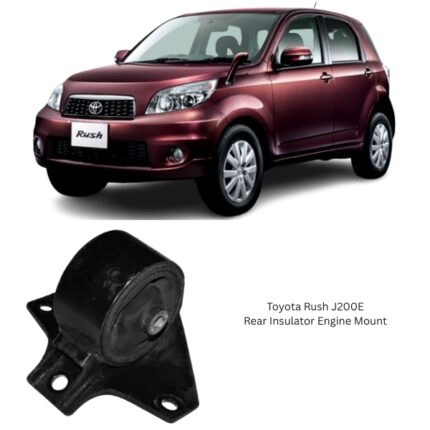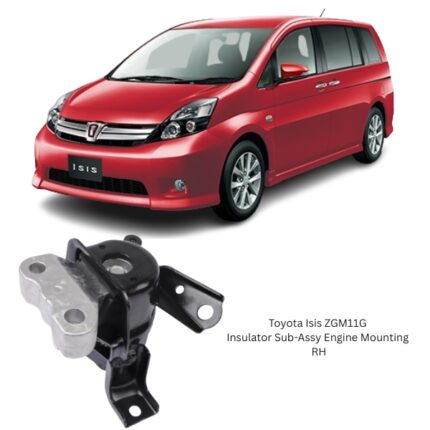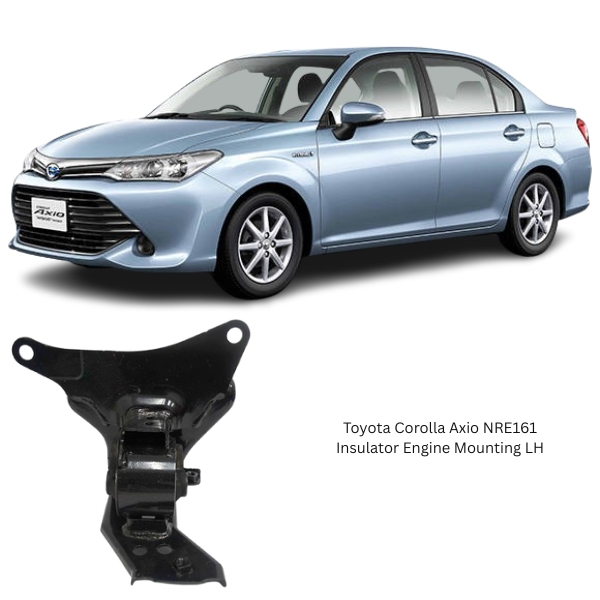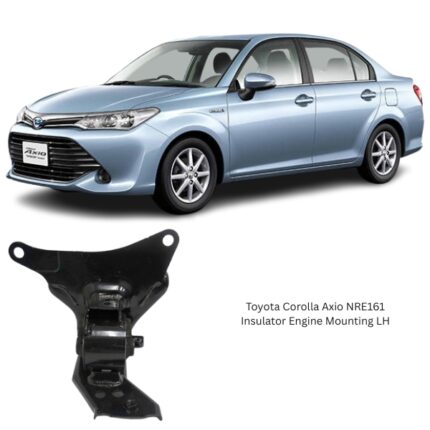Get Toyota Corolla Axio NRE161 Insulator Engine Mounting LH 12372-47160 in Kenya
The Insulator Engine Mounting LH (Left-Hand Side) is a critical part of a vehicle’s powertrain support system, designed to secure the engine to the chassis while also absorbing and isolating vibrations, shock, and torque from engine operation. Positioned on the left-hand side of the engine bay (as viewed from the driver’s seat), this component works in tandem with other engine mounts to stabilize the engine under a variety of driving conditions, ranging from idle to high-load acceleration.
Engine mounting insulators are engineered to enhance ride comfort, reduce Noise, Vibration, and Harshness (NVH), and protect structural integrity by maintaining the engine’s proper position within the bay. The LH engine mount, in particular, handles a portion of the engine’s static weight and dynamic motion, especially lateral movements caused by cornering or engine torque.
Function and Purpose
The LH engine mounting insulator performs multiple critical functions:
-
Engine Stabilization: Prevents unwanted engine movement during acceleration, deceleration, braking, and turning.
-
Vibration Damping: Absorbs and isolates vibrations generated by the engine before they reach the cabin.
-
Alignment Preservation: Maintains proper engine positioning for optimal alignment with the transmission and driveline.
-
Noise Reduction: Minimizes engine noise transferred to the chassis and interior.
-
Component Protection: Reduces mechanical stress on adjacent parts such as exhaust systems, hoses, wiring, and sensors.
This component plays an indispensable role in enhancing overall driving comfort and mechanical harmony across the powertrain system.
Construction and Materials
The Insulator Engine Mounting LH is a precision-engineered assembly built to endure extreme engine conditions including heat, vibration, and chemical exposure. It typically consists of the following elements:
1. Mounting Brackets
Usually constructed from forged steel or cast aluminum, the brackets provide strong, durable interfaces between the engine block and the vehicle chassis.
2. Elastomeric Core
The heart of the mount is a specially formulated rubber or polyurethane insulator, which cushions the engine and dissipates vibrational energy. The durometer (hardness) of this elastomer is carefully chosen to balance flexibility and support.
3. Metal Sleeve or Core Insert
A cylindrical metal sleeve runs through the center of the rubber, allowing the bolt to pass through and providing structural support.
4. Hydraulic Chamber (Optional)
Some advanced mounts include a fluid-filled chamber to enhance vibration damping, particularly at low RPM or idle.
5. Heat Shield (Optional)
If located near hot components, the mount may be equipped with a metal heat shield to prevent thermal degradation.
These components are bonded together with high-strength adhesives and molding techniques to ensure long-lasting performance even under constant load cycles and exposure to harsh operating environments.
Performance Characteristics
A high-quality LH engine mount must exhibit the following characteristics:
-
Durability: Long service life under heat, mechanical stress, and vibration.
-
Effective Vibration Isolation: Ability to dampen high- and low-frequency vibrations.
-
Static and Dynamic Load Bearing: Supports the engine’s weight and dynamic forces during acceleration, deceleration, and road irregularities.
-
Temperature Resistance: Maintains elasticity and integrity under varying thermal conditions.
-
Corrosion Resistance: Withstands environmental exposure without rust or material breakdown.
When performing properly, the insulator contributes to vehicle stability, drivability, and comfort by ensuring that engine movement is limited and well-controlled.
Common Symptoms of Failure
Over time, the LH engine mount insulator can deteriorate due to repeated heat cycles, exposure to engine fluids, or simple material fatigue. Common signs that the mount may be failing include:
1. Excessive Engine Vibration
Vibrations felt in the steering wheel, floorboard, or dashboard—especially during idle—may indicate that the rubber insulator has hardened, cracked, or collapsed.
2. Engine Movement
Excessive rocking or shifting of the engine when revving, accelerating, or turning off the ignition suggests the mount is no longer holding the engine firmly.
3. Clunking or Thudding Noises
A broken or collapsed mount may allow the engine to contact the chassis, producing knocking sounds when driving over bumps or changing gears.
4. Uneven Engine Alignment
Visual signs of a tilted or off-center engine in the engine bay often indicate an issue with one or more mounts.
5. Cracked Rubber or Leaks
Visible cracks in the rubber or leaking fluid from hydraulic mounts are signs of physical failure.
Addressing these issues promptly prevents secondary damage to engine components, transmission mounts, and suspension systems.
Installation Process
Replacing the LH engine mount should be done with care to avoid stress on other mounts or engine misalignment. General installation steps include:
-
Ensure Safety
Park on a level surface, engage the handbrake, and disconnect the battery. -
Support the Engine
Use an engine hoist or hydraulic jack with a block of wood to relieve pressure on the mount. -
Access the Mount
Remove any obstructing components such as air boxes, battery trays, or intake piping. -
Unbolt the Old Mount
Loosen and remove the fasteners connecting the mount to the chassis and engine bracket. -
Inspect Surrounding Components
Check for wear on nearby mounts, brackets, or hoses. -
Install the New Mount
Position the new LH mount in place and tighten all bolts to the correct torque specifications. -
Reassemble and Test
Reinstall removed parts, reconnect the battery, start the engine, and observe for unusual movement or noise.
Maintenance Tips
Engine mounts are generally maintenance-free but should be inspected regularly, especially during:
-
Scheduled engine services
-
Suspension or drivetrain inspections
-
Unusual noise or vibration complaints
-
High-mileage vehicle check-ups
What to check:
-
Visible cracks or damage to rubber
-
Missing bolts or loose fasteners
-
Signs of engine misalignment
-
Leaks in hydraulic mounts
Advantages of Replacing a Worn LH Engine Mount
-
Improved Ride Comfort
Reduces harshness and vibration felt through the cabin. -
Enhanced Powertrain Stability
Prevents excessive movement of the engine and transmission. -
Restored Engine Alignment
Ensures correct positioning for smoother gear engagement and belt operation. -
Protection of Adjacent Components
Reduces stress on exhaust parts, hoses, wiring, and other engine bay items. -
Quieter Operation
Eliminates noises caused by engine-chassis contact or loose movement.
Follow us on Facebook for more parts.





Reviews
Clear filtersThere are no reviews yet.